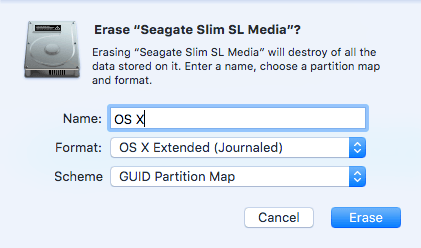

- #FORMAT EXTERNAL HARD DRIVE FOR MAC OS EXTENDED JOURNALED FORMAT HOW TO#
- #FORMAT EXTERNAL HARD DRIVE FOR MAC OS EXTENDED JOURNALED FORMAT PRO#
- #FORMAT EXTERNAL HARD DRIVE FOR MAC OS EXTENDED JOURNALED FORMAT PC#
It will give you a warning about erasing all the data! This is a good time to double-check to make sure you’ve selected the correct drive to erase. This Mac OS Extended (Journaled) selection is what formats the drive for Mac.Ĩ. In the Format dropdown, choose “Mac OS Extended (Journaled).” You can also name your drive by putting something in the Name field, if you want. On the right-hand side of the same window, towards the top, you’ll see “First Aid” “Erase” “Partition” “RAID” and “Restore.” Click on “Erase.”ħ. If that’s the case, select the upper one (the one that’s not indented).Ħ. You might see 2 drives that both look like your new external hard drive–one with one name, and one just below it, indented, with a different name.

One of the items should be the brand-new drive that you just attached to your computer–the one you want to reformat. One of them will be your computer’s internal hard drive one may be the DVD drive that’s in your computer. In the application, on the left-hand side is a white box that shows all your available drives. Double-click on it to run the application.ĥ. Inside your Utilities folder is an application called Disk Utility. In the window that shows up, first type a name for the external hard drive, then select either of the following three formats for the external drive: APFS this format is recommended for SSD drives Mac OS Extended (Journaled) this format is compatible with the biggest number of Macs (newer and older models). Inside your Applications folder is a Utilities folder.
#FORMAT EXTERNAL HARD DRIVE FOR MAC OS EXTENDED JOURNALED FORMAT HOW TO#
(If you don’t know how to do this: Click on the Finder in the Dock, and then in the window that pops open, you should see Applications as one of the items way over on the left side.)ģ. Attach your new drive to your computer via cable (USB or FireWire cable, depending on the drive), and plug it into the wall if it requires wall power, and turn it on if it has a power switch.Ģ. **DO NOT do this with a drive that has data on it! All your data will be erased! Only do it with a brand-new drive.**ġ. Here’s how to reformat a drive for use with Mac. HFS+ also has optional journaled features for improved data reliability. You might get slightly worse performance or see small stability issues.) Also known as Mac OS Extended or HFS Extended, HFS+ is an improvement on the HFS file system, by supporting larger files and using Unicode for naming files. However if you’ll be using the drive only on your Mac, you should do what’s called “reformatting.” (If you’ll be using the drive with both a Mac and a PC, don’t reformat it–leave it as it is. It’s great to have a wider selection, and often a lower price, than just the Mac items on offer. So you can choose based on price and looks. These days you can buy any external hard drive, not just the ones labeled for Mac. The drive should now be formatted Mac OS Extended (Journaled) and can be confirmed by selecting the indented entry which will now show Mac OS Extended (Journaled) Volume under the name you provided. Photo by Miss Karen, courtesy Flickr Creative Commons.ĭid you know that when you buy an external hard drive to use with your Mac, it’s usually a good idea to set it up for Mac use? Click the Erase button, Disk Utility will start formatting the drive. Andy Kiernan on Confetti with a logo/icon as a particle.An external hard drive in use.
#FORMAT EXTERNAL HARD DRIVE FOR MAC OS EXTENDED JOURNALED FORMAT PRO#
Would this be enough or would still be too slow to use for editing?ĥ- Have two hard drives, one with the partition (Mac Os Extended and ExFat) and another with NTFS -so they could use ExFat to copy anything in between the systems, while they use for editing drives in the OS format.ĪJA Announces KONA 5, Io 4K Plus, and T-TAP Pro Support for Hardware Out in Microsoft Teams
#FORMAT EXTERNAL HARD DRIVE FOR MAC OS EXTENDED JOURNALED FORMAT PC#
When working in PC they would just use the ExFat partition. But I’ve read ExFat is prone to corruption and makes the drives really slow to read in MacĤ- Create a partition on their drives with both Mac Os Extended and ExFat – I suppose they could have their material in the ExFat partition and write in the Mac partition when working in Mac. So I’m now looking at what the best options to format their drives are.ġ- Formatting their drives as Mac Os Extended (Journaled) and use a program to allow their PCs to read and write on their drives (like HFSExplorer, Paragon HFS+ or MacDrive) – Faster when working on Mac, I don’t fully know how the drives will be performing in PCĢ- Formatting their drives as Fat32 – Compatible both in Mac and PC but the files are limited to 4Gbģ- Formatting their drives as ExFat – Compatible both in Mac and PC and the files are not limited to any size. I’ve seen that they can open Premiere in both Mac and PCs when using the exact same version. But some students have PCs at home so they want to be able to move between both systems. The students have access to Premiere on Macs.


 0 kommentar(er)
0 kommentar(er)
